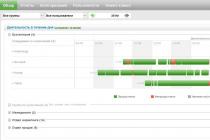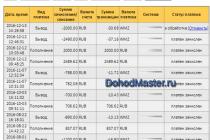The situation when a new processor requires a new motherboard with a new chipset has already been encountered quite often. All motherboard manufacturers were in a hurry to introduce their new products, playing chicken and egg. However, as you already know, things are going differently this spring - new Intel processors, codenamed Ivy Bridge, can be used on "old" boards. But this does not mean at all that the leaders of the component market should not worry - users who want everything new are the most active and very interesting financially, so everyone was enthusiastic about the release of the seventh series chipset line.
In the arsenal of ASUS, a dozen products appeared at once on the maximum version of the chipset line - Intel Z77. Honestly, in our opinion, this is overkill: it will not be easy for users to understand the differences and numerous suffixes when it comes to ordinary "workhorses". In this article, we will take a look at the P8Z77-V Pro motherboard.
Among its distinctive features, the manufacturer mentions the use of a Digi + chip to control power circuits, the possibility of using four-chip SLI and CrossFireX, and a fan control system in the Fan Xpert 2 case.
Package and proprietary utilities
Traditionally, out of a dozen models based on one chipset, only a few were awarded the original packaging. Our today's hero is out of luck - an ordinary medium-sized cardboard box. Its design, at first glance, hardly differs from many other mass devices. But upon closer examination, you can notice the texture (relief) on the cardboard.

Draws on itself detailed description numerous features of the board. It is a pity that only in English. Moreover, these are not just technical characteristics rewritten with beautiful words, but really unique functions of the device. We will dwell on some of them in more detail below.
The scope of delivery for this model is quite rich: a dummy for the rear panel of the board with a black insert and connectors' signatures, two SATA 6 Gb / s cables with latches (one straight connector, the other angled), two "simple" SATA cables with the same connectors, flexible SLI bridge, special adapters for easy connection of connectors on the front panel of the case to connectors on the board (one for buttons and indicators, the other for USB ports), a bracket for the rear panel of the case with a pair of USB 2.0 ports and one eSATA, a proprietary Wi- Fi with external antenna, thick user manual (on English language), DVD with drivers, programs and documents.

The motherboard comes with a lot of utilities, some of which deserve special consideration in a separate article, and we will try to return to this issue in the near future. All of them are collected in a single AI Suite II shell to simplify both installation and work with them.

From the manufacturer's website you can download updated version set in the form of one archive. The set includes utilities for monitoring system status, collecting system information, updating software and BIOS, managing a Wi-Fi controller (including for organizing an access point), configuring USB ports, selecting power saving modes, setting power management, overclocking the system, installing prioritizing network traffic, remote control from wireless mobile devices.

The TurboV utility is used to automatically overclock the system. We checked its performance in automatic mode with a processor Intel Core i5-2500K and Corsair H100 liquid cooling system. The choice of the "Fast" profile made it possible to increase the processor frequency by one third in just a couple of seconds - up to 4.3 GHz.

A longer process in the Extreme profile showed even more impressive results - the frequency exceeded 5.2 GHz. However, it should be noted that the second option turned out to be unstable under the load of the LinX program. In the "beautiful" mode 5 GHz (100 MHz × 50), the system coped with this test as well. We also mention the presence of an automatic reset system in case of unsuccessful overclocking.
Features of the board
The motherboard uses black PCB, which makes it look both strict and stylish. It has a standard ATX size (304 × 244 mm), so that all configuration elements could fit freely. The LGA1155 socket can be used with both 32nm and new 22nm Intel processors (codenamed Sandy Bridge and Ivy Bridge, respectively). It cannot be said about most modern motherboards that there is a lot of free space near the socket and it will be easy to install a cooling system of any format. The product in question is no exception to this rule, but everything is arranged according to the standard, and boxed coolers will of course be installed without problems. And if you are thinking of purchasing something larger and more effective, we recommend that you first make sure that it can be installed.

This model has four slots for DDR3 RAM. The manufacturer says it can work at frequencies up to 1200 MHz (DDR3-2400) inclusively in overclocking mode. XMP profiles are supported - in particular, Kingston test modules worked without problems in their "native" DDR3-2133 mode (it was enough to change only one parameter in BIOS Setup). The latches on the slots are "one-sided", which is intended to simplify the installation of modules, although efficiency can be argued. We did not forget about the MemOK! Button, which will help start the system in case of installing "not very compatible" memory modules.

Expansion slot configuration is tricky. Differences in color coding do not help to figure it out. There are two PCIe x16 slots connected to the processor and capable of operating in x16 mode with one video card installed in the first slot, and in x8 + x8 mode with two video cards. These ports support the 3.0 standard if the corresponding processor is installed (this is also confirmed by the use of ASMedia standard chips for switching). The location of these slots allows cards with three-slot cooling systems to work. The third slot of x16 format version 2.0 works through the chipset and supports the maximum x4 mode. According to the manufacturer, it shares the chipset lines with other slots (both PCIe x1) and external controllers (internal USB 3.0 and SATA 6 Gb / s ports on ASMedia chips). So with the maximum use of all devices, you can expect only x1 mode from it.
The last pair - PCIe x1 slots - are located on both sides of the "main" graphics slot. So one of them will be free in any configuration (if a large processor cooler does not interfere), and the second will in most cases be unavailable when installing an external gaming video card, since most of them have a dual-slot cooling system. In addition, these ports share PCIe lanes with a third PCIe x16 slot, and the second with an external SATA 6Gb / s chip.
Numerous external controllers and a wide range of expansion ports make full use of the 8 PCIe 2.0 lanes available in the chipset. We also note the support of this board for the LucidLogix Virtu MVP technology (we wrote about LucidLogix Virtu), designed to increase performance graphics applications thanks to the combined use of the integrated and external video cards, although, in our opinion, it is more convenient to buy a more efficient external video card than to count on this function.
An 8 MB BIOS chip is installed on the socket, but in most cases this will not be useful - this board implements the USB BIOS Flashback technology. It allows you to restore a completely "killed" firmware from a USB flash drive plugged into a dedicated USB port with an image. For this, a specialized microcircuit is used on the board. True, you will have to open the case - to access the button for starting the recovery process.
Like many other ASUS motherboards, the P8Z77-V Pro has dedicated LEDs to help you identify the root cause of boot problems. Moreover, this does not require a long study of the documentation and codes - the indicators are located near all critical elements (processor, memory, video card port).
Most connectors motherboard collected along its lower edge (left in the photo). Moreover, they occupy it almost completely (except for two connectors absent in this modification of the board). This can make it difficult to access the emergency button. BIOS recovery... The jumper for resetting CMOS is also not very convenient - it is too close to the connectors.
Power and cooling circuits
Connection to the power supply is made using standard 24-pin and 8-pin connectors (it is possible to work with a four-pin connection using an ATX12V connector). Several Digi + chips are used to control the power supply of the system components. The manufacturer calls this "Dual Intelligent Processors 3" technology. In total, the processor receives 12 phases, four for the graphics core (in this case, we are talking about the operation of an eight-channel PWM controller with phase doubling), and two for the RAM.

The elements of the processor power supply circuits near the socket are covered with relatively small aluminum heatsinks about 25 mm high. Note that their design is complemented by plates on the back of the PCB. There are no heat pipes here, which is more good than bad. You can also see a heatsink with a complex shape of the upper surface on the chipset microcircuit. Its height is only 12 mm and it will not interfere with the installation of expansion cards - except access to the latches of the PCIe x16 slots. This configuration of the cooling system is more than enough for the model under consideration. In our tests with an overclocked Intel Core i5-2500K processor, we used a leisurely 120mm fan to flow to the power heatsinks as the processor had a liquid cooling system. In these conditions, their temperature did not cause any concern.

To connect fans on the board, there are as many as six connectors - "double" for the processor and four for the case. They are all four-pin and auto-speed control to create an efficient and quiet system. Let us note the implementation of the new unique Fan Xpert 2 technology in this board. It is able to provide the necessary temperature regime while maintaining a low level of system noise. To do this, after assembling the PC, installing and connecting all the fans, you need to run a special program that automatically calibrates the operation of the fan system: it will be able to determine the effect of each fan on the temperature of system components and suggest the optimal operating mode.
In this section, we will also mention the presence of TPU and EPU switches and indicators on the board. The first activates the function of automatic overclocking of the system with the participation of the chip of the same name. You can use it after loading the operating system through a proprietary utility. EPU is designed to reduce system power consumption by dynamically managing power circuits.
BIOS
BIOS is implemented using UEFI technology and is based on AMI code. It allows for mouse control (although you cannot do without a keyboard) and has several localization options. One cannot look at Russian without tears - as if China has the only version of the Russian script that can often be found in “nameless” smartphones.

The first page that the user sees after entering BIOS Setup is an implementation of a simplified version of "EZ Mode". Here you can check the configuration of the processor, memory, hard drives, view the monitoring data of the sensors built into the board (temperatures, voltages, fans), change the boot order and select one of the “optimization” modes of the processor parameters - “eco”, “normal”, “optimal ASUS version ".

To access the full set of settings, you need to go to the "Advanced Mode". It traditionally contains sections:
- Main - displaying the BIOS version, setting the time and date;
- Ai Tweaker - settings for frequencies, voltages and modes for overclocking and system optimization;
- Advanced - setting CPU / PCH / SA parameters, setting up SATA and USB, external controllers;
- Monitor - monitoring system sensors, setting Q-Fan to control the fan speed;
- Boot - OS boot parameters, device selection;
- Tool - access to the BIOS EZ Flash firmware utility, control overclocking profiles, display information from SPD memory modules (including XMP).
We do not recommend for beginners to go to Ai Tweaker, at first glance there are about a hundred parameters. Moreover, effective overclocking can be carried out with a proprietary utility from Windows. The rest of the points are quite simple and do not cause any problems with finding the desired options.
Functionality
Most of the space on the rear panel is occupied by video outputs - there are four of them for every taste: VGA, DVI-D, HDMI, DisplayPort. It is difficult to say whether such a configuration is really in demand, but the fact that no adapters are required to connect any monitor can be considered a plus. The PS / 2 connector has long been worth scrapping, it is better to install another pair of USB or eSATA instead. By the way, this board has none of the latter. This is slightly offset by the fact that 4 USB port correspond to version 3.0 of this interface. Moreover, two of them are chipset, and the second pair is powered by an external controller. USB 2.0 ports are implemented by the chipset controller.

Audio outputs and network are standard - analog mini-jacks for 7.1 configuration, digital optical S / PDIF-Out, RJ-45 port with built-in indicators. A separate place is assigned to the Wi-Fi controller for connecting the antenna and the LED for indicating the operation.
Despite the use of the modern multifunctional Intel Z77 chipset, this motherboard has many additional controllers that add new functions and expand existing ones. The complete list consists of:
- two USB 3.0 controllers based on ASMedia ASM1042 (PCIe x1) microcircuits, each with support for 2 devices, two ports are routed to the rear panel, two to a bracket connector for connecting to connectors on the case;
- integrated audio based on the HDA codec Realtek ALC892 in 7.1 format, with an optical S / PDIF-Out connector on the rear panel of the board and an additional S / PDIF-Out connector on a PCB;
- a gigabit network controller based on a MAC controller in the chipset and an Intel PHY;
- PCI bus controller on the ASMedia ASM1083 chip (PCIe x1) for the implementation of two slots;
- SATA controller ASMedia ASM1061 (PCIe x1) with support for two internal SATA 6 Gb / s ports.
The motherboard has eight SATA connectors for connecting drives. Six of them are chipset, two of which support 6 Gbps interface speed. The remaining two are implemented on an external ASMedia controller and also support 6 Gbps. The ports are located near the edge of the board at an angle so that their cables will not interfere with expansion cards. Color coding makes it easy to identify the type of port. An external eSATA port can be realized by connecting a complete bracket for the rear panel of the case (the connector from it is plugged into any port on the PCB of your choice, providing the speed and functionality of the eSATA port that you need "on the back"). The chipset controller supports RAID 0, 1, 5, 10, Matrix RAID and Intel technologies - Smart Response, Rapid Start and Smart Connect. By the way, ASUS decided to offer its own utility for using an SSD as a cache for a hard drive.
The built-in audio codec implements standard modes with connection to analog outputs up to 7.1, and also supports digital sound, including HD tracks in BD and output via stock HDMI.
For the first time for Intel, Z77 has built-in USB 3.0 controllers (recall that exactly how 3.0 they work today only in Windows 7, since only there are corresponding drivers for it). But ASUS decided to add a couple of external controllers as well. As a result, the user gets four ports version 3.0 and two versions 2.0 on the rear panel, as well as connectors on the board for four more ports 3.0 and eight 2.0. The board supports the USB 3.0 UASP standard (you can read more about this technology in the ASUS P9X79 Pro review) for ports based on ASMedia chips, and fast charging mobile devices (USB Charger +).
One of the innovations in this line of motherboards is the complete set wireless module... To be honest, the implementation, in our opinion, was chosen somewhat strangely. Today there are good USB controllers that provide high-speed 802.11n operation. They are easy to select, connect and use. But ASUS went its own way - a standard half mini-PCIe card is installed in a proprietary adapter, which is placed on the motherboard in a special slot between the rear panel connectors and secured with a screw from the back. An antenna (or several) also uses micro-connectors of its own, original format. As a result, the user is faced with many restrictions - it is impossible to install another board, it is difficult to replace the antenna, and this product cannot be used with other devices. Perhaps it was the last point that became the reason for such a design. The P8Z77-V Pro uses the Qualcomm Atheros AR9485 single-channel single-band chip, supporting a maximum connection speed of 150Mbps. Note that other motherboards in this series have more efficient solutions.
The presence of two standard PCI slots on the board will be of interest to users who need to use expansion cards of the old standard.
Conclusion
The announcement of a new chipset and a new line of processors has once again spurred manufacturers to update their products. Wanting to maintain the high status of one of the market leaders, ASUS has released a dozen models on the Z77 chipset at once. Choosing the right one is not an easy task. And even the presence of the product comparison function on the company's website does not help much in this situation. So we recommend that you write down the exact requirements and "try" them on the solutions presented on the market.
The ATX format made it possible to implement a rather interesting configuration of expansion slots on the P8Z77-V Pro, allowing the simultaneous operation of three video cards. Also, this model has two PCI slots available, which may be of interest to users who did not have time or could not replace equipment with a more modern one. Note the use of a network controller by Intel itself, which are considered exemplary, albeit more expensive, and the availability wireless adapter 802.11n standard (but the lowest configuration). Other additional controllers add four USB 3.0 ports and a pair of SATA ports to the chipset's capabilities. The rest of the product parameters are quite consistent with the modern solution for building a high-performance computing system based on Intel processors Core of the past and last generations. From proprietary programs and technologies, we mention TurboV for system overclocking and Wi-Fi Go! for working with mobile devices. the current price (number of offers) of this model in Moscow retail: N / A ()
ASUS P8Z77-M today is a compact size motherboard that has a set of all the necessary functions. At the heart of this decision there is a slightly outdated platform based on the LGA 1155 socket.
However, its capabilities will be quite enough to create a compact, productive computer system. Who was this product for?
ASUS P8Z77-M: technical features
First of all, it should be noted that this motherboard is perfect for those cases when it is necessary to assemble a system that demonstrates the maximum level of performance in one compact case. The reliability of such a computer will not cause any complaints. The motherboard ASUS P8Z77-M is made in a miniature MicroATics format. However, it is based on the most functional set of system logic. This allows for the most flexible setting of all parameters. All elements installed on the board have only passive cooling. However, it is possible to install four coolers in such a computer system at once. One of them is intended directly for installation in the central processing unit, and the other three are intended for installation on the case. For this reason, no problems with cooling during overclocking should arise in this situation.
ASUS P8Z77-M: package contents
The ASUS P8Z77-M motherboard is bundled as follows. In the box with the device, the user can find directly the motherboard itself, cords for connecting SATA drives, a metal plug for the rear panel of the system unit, a disk with drivers and software. All this should be enough for assembly. personal computer... In this case, there is no need to purchase any additional elements.
ASUS P8Z77-M: location of components on printed circuit board
ASUS P8Z77-M measures 244 x 244 mm. If we consider the appearance of this component, we can conclude that there are three passive cooling systems on the board at once, built on the basis of aluminum radiators. Two of these systems are used to remove excess heat from the power supply system of the central processing unit. The third cooling system is used to cool the chipset south bridge. The processor socket is located in the center of the upper part of the board. To the left and top of it are the previously mentioned cooling systems for the processor batteries. On the right side, there are slots for installing RAM bars. Further down in this direction is the power connector. There are expansion slots just below the socket, which can be used to install additional external controllers and graphics adapters. On the right side of the expansion slots, there are ports for installing SATA drives. There should be no problems with the installation of any component of this kind, since the expansion and RAM slots are located correctly.
ASUS P8Z77-M: chipset
As you might guess from the name, the ASUS P8Z77-M motherboard is built on the basis of an advanced system logic set designed for the LGA 1155-Z77 computing platform. This product consists of only one microcircuit, namely the south bridge, which is responsible for processing information from the drive connection ports and expansion slots. In this case, the northbridge, which could be found in earlier products of this company, has been moved to the CPU. The North Bridge provides interoperability with RAM and peripherals.
ASUS P8Z77-M: socket and semiconductor chips
As noted earlier, the ASUS P8Z77-M motherboard is equipped with an LGA 1155 socket. This processor socket can accommodate 2nd and 3rd generation Core chips. As a result, you can install Core i7, Core i5, Core i3, Celeron and Pentium vultures in the socket, which belong to the given generations of semiconductor crystals. Given that the system logic set in this case is Z77, it will be optimal to use the CPU with an unlocked multiplier. At the end of the designation, such devices have the letter "K". This will give you the opportunity to maximize your potential. computer system.
ASUS P8Z77-M: a set of interfaces
ASUS P8Z77-M motherboard is equipped with the following ports for connecting external devices: one PS / 2 port for connecting a keyboard and pointing device-mouse, six USB ports, four of which are 3.0 and two 2.0. Graphics ports on the motherboard are HDMI, DVI and D-Sub ports. When a monitor is connected to these ports, only the graphics adapter integrated into the central processing unit will be used during operation. The board provides two eSATA ports for connecting external drives. ASUS P8Z77-M also has a set of inputs and outputs for a sound card.
ASUS P8Z77-M: expansion slots
It should be noted that ASUS P8Z77-M PRO has a fairly large set of expansion slots. In the overview of technical specifications this extension you can see the complete absence of a PCI slot. but this standard today it can already be considered morally obsolete. Such cards today remain mostly only after upgrading an outdated computer system and are transferred to a new PC during the upgrade. In this situation it would be better to use a full-format ATix board with this connector. However, it should be understood that the presence of this component in a PC can significantly reduce the level of performance. So there is nothing to worry about in the absence of such an expansion slot. In practice, it can be replaced with a similar USB adapter... This computer component has four memory slots. All DDR3 bars are supported. The maximum amount of RAM that can address this model system board is 32 GB. ASUS P8Z77-M PRO motherboard has only one PCI Express 1X slot for installing an additional internal controller in a PC. In this case, three PCI Express 16X slots are allocated to install graphics adapters. In this case, you can make a choice. If you install an advanced video card in the first slot, then it will no longer be possible to put the controller in the PCI-Express 1X slot. It should be noted that the miniature dimensions of the motherboard in this case impose certain restrictions.
ASUS P8Z77-M PRO: BIOS
The "BIOS" of this computer accessory includes many different parameters. This allows for flexible configuration of the computer system in the process of overclocking the central processing unit. Ultimately, this allows for a solid performance boost. There is also UEFI on this board. This is special software component with similar functionality, but unlike BIOS, its interface is Russified.
ASUS P8Z77-M PRO: reviews
ASUS P8Z77-M PRO is an almost flawless solution. It has really great features and a wide range of interfaces. It should also be noted that the board turned out to be rather diminutive. At the same time, the cost for a computer component of this level turned out to be very democratic. There is only one drawback: if you install a powerful graphics accelerator in the slot, you will not be able to install an additional controller in the PCI-Express 1X slot. However, the level of functionality of this motherboard is quite high, so the lack of such an opportunity in this case is not critical.
ASUS P8Z77-M PRO: cost and relevance
In the middle of last year, the ASUS P8Z77-M PRO motherboard was available for $ 110. Today it is rather problematic to find such motherboards on sale. Moreover, their cost can range from $ 50 to $ 100. Everything will depend on the state of the device. It doesn't make much sense to buy such a board to build a new computing system. However, there are also more recent and advanced platforms from this manufacturer, which are now recommended to pay attention to when assembling a new PC.
The motherboard discussed in this review is a representative of the mid-range price range and is intended for building productive and reliable work or home PCs with a wide range of tasks. The motherboard is made in the mATX form factor and is based on the Intel Z77 Express system logic set, thanks to the latter, it provides the ability to overclock the processor with an unlocked multiplier. Let's go directly to the review of the motherboard and carefully its capabilities.
Motherboard specification ASUS boards P8Z77-M:
|
Manufacturer |
|
|
Intel Z77 Express |
|
|
CPU socket |
|
|
Supported processors |
Intel Core i7 / Core i5 / Core i3 2nd and 3rd generation |
|
Memory used |
DDR3 2400 (O.C.) / 2200 (O.C.) / 2133 (O.C.) / 1866 (O.C.) /1800(O.C.) / 1600/1333/1066 MHz |
|
Memory support |
4 x DDR3 DIMM dual channel architecture up to 32 GB |
|
Expansion slots |
1 x PCI Express x16 3.0 / 2.0 |
|
Disk subsystem |
Intel H77 Chipset Supports: |
|
Sound subsystem |
Realtek ALC887 8-Channel High-Definition Audio Codec with Optical S / PDIF Out |
|
LAN support |
Gigabit LAN controller Realtek 8111F |
|
24-pin ATX power connector |
|
|
Fan connectors |
1 x for cpu cooler |
|
External I / O ports |
1 x PS / 2 |
|
Internal I / O ports |
2 x SATA 6.0 Gb / s 1 x COM |
|
64 Mb Flash ROM, UEFI AMI BIOS, PnP, DMI2.0, WfM 2.0, ACPI v2.0a, SM BIOS 2.5, |
|
|
Proprietary technologies |
ASUS Quiet Thermal Solution |
|
Equipment |
Instruction and manual SATA 6Gb / s cable SATA 3 Gb / s cable |
|
Form factor Dimensions, mm |
mATX |
|
Products webpage |
Fresh BIOS version and drivers can be downloaded from the support page |

The packaging of the ASUS P8Z77-M motherboard has a familiar design in dark colors. The front of the package contains the name of the motherboard, and the lower part is occupied by pictograms indicating the technologies used.

The reverse side of the box is more informative. Here you can see a photo of the motherboard and its specification, as well as a description of the most interesting technologies from the point of view of the marketing department.

The package contents of the ASUS P8Z77-M motherboard are sufficient for assembling the system. In the box with the motherboard you can find:
DVD with software and drivers;
user manual in English and short installation instructions;
two Serial ATA 6.0 Gbps cables;
ASUS Q-Connector set;
cap on the rear panel of the case.

Motherboard ASUS P8Z77-M is made in mATX form factor and measures 244 x 244 mm. The layout is well done, all connectors are in accessible places. The only exception is some overcrowding of USB 3.0, ATX and SATA connectors. But if you follow a certain connection sequence, then such an arrangement of connections will not cause any particular inconvenience. On the positive side, the RAM slots are devoid of latches on the bottom side, this will make it much easier to replace or add RAM modules with a video adapter installed. There are 8 mounting holes on the board, while the lower right corner is left without a hole, which is the reason for its "sagging", so you need to be careful to connect to the ports located here.

The cooling system is passive and includes two stylized heatsinks: one removes heat from the heating elements of the processor power converter, and the other cools the PCH Intel Z77 Express. During testing, a temperature of 42.2 ° C was recorded on the heatsink, which is a typical indicator among similar motherboards.

The disk subsystem of the ASUS P8Z77-M motherboard is implemented exclusively by the Intel Z77 Express system logic set. The board contains four SATA 3Gb / s ports and two SATA 6Gb / s ports. There is support for arrays of RAID levels 0, 1, 5 and 10.


In addition to the ports brought out to the interface panel, the following connection pads are present on the motherboard:
3 x USB 2.0 (up to 6 additional ports);
1 x USB 3.0 (up to 2 additional ports);
In total, the ASUS P8Z77-M motherboard has ten USB 2.0 ports and four USB 3.0 ports, which is quite enough for connecting various devices.

There are four connectors on the motherboard for installing expansion cards:
1 x PCI Express x16 3.0 / 2.0;
1 x PCI Express x16 2.0 (x4);
1 x PCI Express x1;
It is allowed to install two video adapters in AMD CrossFireX mode, but due to the low bandwidth of the second PEG connector, this will not be the most rational solution. Note the presence of a PCI slot, which can still be useful for installing outdated expansion cards.

The motherboard in question is equipped with four 240-pin DIMM sockets with dual channel architecture to work with DDR3 memory. The maximum total memory capacity can be up to 32GB with four 8GB modules. The maximum frequency of the RAM is 2400 MHz in overclocking mode. To organize memory operation in dual-channel mode, it is necessary to fill the slots of the same color.

As on most ASUS motherboards, there is a “MemOK!” Button near the memory slots, which will be useful if there are errors in the system memory.

The processor supply voltage converter is made according to the 4 + 1 + 1 phase scheme. One phase is used to power the "system agent" and the video core, and the other four are used to power the processor cores. The ASP1102 microcircuit manufactured by CHiL Semiconductor Corp. is traditionally used as a PWM controller. Cooling of the power unit has been improved through the use of a stylized radiator with rather large fins. The processor is powered via an 8-pin EPS12V connector, which is rated for more current than a conventional 4-pin ATX12V connector.

The ASMedia ASM1442 chip is responsible for switching the HDMI and DVI video outputs.

The sound subsystem of the motherboard is based on the HDA codec for 8-channel audio Realtek ALC887, and for connecting to local network the gigabit network controller Realtek 8111F is used. Such controllers are installed by most of the motherboard manufacturers, which guarantees that there are no problems with the drivers.

Since the Intel Z77 Express system logic set does not support the PCI bus, the manufacturer added a PCI Express to PCI bridge to implement it. The ASMedia ASM1083 chip acts as such a bridge.

Nuvoton NCT67790 microchip controls PS / 2 and COM ports, system fans and provides temperature monitoring.

The following ports are displayed on the interface panel of the ASUS P8Z77-M motherboard:
1 x PS / 2 for mouse or keyboard;
optical S / PDIF;
RJ45 connector for network connections;
three 3.5mm audio jacks.
Noteworthy is the presence of the most common monitor connectors, there are both analog D-Sub and two types of digital video outputs. But the presence of only three audio connectors can cause some inconvenience when connecting multichannel speakers.

ASUS P8Z77-M motherboard has four fan headers. One four-pin connector is for connecting a processor fan, and the rest are for connecting case fans.
UEFI BIOS

The ASUS P8Z77-M motherboard, like many other solutions based on Intel 7x Express system logic, uses UEFI with a graphical interface as a preloader.
Going to the "AI Tweaker" section with settings for overclocking and optimizing the system, you can note a rather long list of options responsible for the frequency, supply voltage and even the operating mode of the processor power converter, and this despite the fact that ASUS P8Z77-M is not positioned as solution designed for overclocking.
The settings required for overclocking are summarized in the table:
|
Parameter |
Menu name |
Range |
|
|
Processor technology |
C1E, Intel Adaptive Thermal Monitor, Virtualization Technology, |
||
|
System bus frequency |
BLCK / PCIE Frequency |
80 - 300 MHz |
|
|
RAM frequency |
800, 1067, 1334, 1601, 1868, 2135, 2402 |
||
|
RAM latency |
DRAM Timing Control |
CAS Latency, RAS to CAS, RAS PRE, RAS ACT, COMMAND Mode, RAS to RAS, REF, Cycle, DRAM Refresh, WRITE Recovery, READ to PRE, FOUR ACT WIN, WRITE to READ, CKE Minimum, CAS Write, RTL ( CHA), RTL (CHB), tWRDR, tRWDR, tRWSR, tRR, tRRSR, tWW (DD), tWW (DR), tWWSR |
|
|
Power limitation during sustained acceleration |
Long Duration Power Limit |
||
|
Duration of long acceleration |
Long Duration Maintained |
||
|
Power limitation during short-term acceleration |
Short Duration Power Limit |
||
|
Main current limit |
Primary Plane Current Limit |
0.125 - 1023.875V |
|
|
Secondary current limit |
Secondary Plane Current Limit |
0.125 - 1023.875V |
|
|
Fixed frequency power circuit |
CPU Fixed Frequency |
200 - 350 kHz |
|
|
CPU supply voltage |
CPU Manual Voltage |
||
|
Voltage on memory modules, V |
1.185 - 2.135V |
||
|
0.61 - 1.560V |
|||
|
Northbridge tension |
0.8 - 1.685V |

The memory frequency multiplier allows you to set the frequency from 800 MHz to 2400 MHz.

You can also configure the timings (delays) and sub-timings (secondary delays) of the RAM in the “manual” way in the “DRAM TimingControl” section.

There is also a separate monitoring section where you can follow:
temperature of the motherboard and processor;
the rotation speed of the processor and case fans;
processor core voltage;
voltage on power lines + 12V, + 5V and + 3.3V.
The section is very informative, only the readings of the voltage supply of the RAM are missing.
In addition, in this section you can enable the function of automatic control of the CPU cooler CPU Q-Fan Control and case fans, which have different intensity modes.
Separately, we note the ability to select the Russian language in the language settings.
Utilities

Overclocking the system and changing the supply voltage of various components can be done using the ASUS TurboV EVO utility.




An interesting feature, typical mainly for ASUS motherboards, is the ability to adjust the operating mode of the processor power stabilizer.
Overclocking capabilities
Overclocking capabilities were tested using an Intel Core i5-2500K processor with an unlocked multiplier.

When using the auto overclocking function, a fairly good result was achieved - 4.3 GHz.

V manual mode the result was slightly higher and amounted to 4.4 GHz.
As you can see, despite its modest dimensions, the ASUS P8Z77-M motherboard is quite capable of unlocking the potential of a CPU with an unlocked multiplier.
Testing
The following equipment was used to test the capabilities of the motherboards:
|
CPU |
Intel Core i5-2500K (LGA1155, 3.3 GHz, L3 6MB) |
|
Scythe Kama Angle Rev.B |
|
|
RAM |
2x DDR3-2000 1024 MB Kingston HyperX KHX16000D3T1K3 / 3GX |
|
Video card |
MSI R4850-2D1G-OC (Radeon HD 4850, 1 GB GDDR3, PCIe 2.0) |
|
HDD |
Seagate Barracuda 7200.12 ST3500418AS 500GB SATA-300 NCQ |
|
Optical drive |
ASUS DRW-1814BLT SATA |
|
Power Supply |
Seasonic SS-650JT Active PFC (650W 120mm fan) |
|
CODEGEN M603 MidiTower (2x 120 mm blower / blower fans) |
Test results:



The performance level of the ASUS P8Z77-M motherboard is the same as that of other solutions, which indicates a high level of performance of the motherboard and good BIOS optimization.
Testing the audio path based on the Realtek ALC892 codec
Overall Results (RightMark Audio Analyzer)
16-bit, 44.1 kHz
The audio subsystem received an average rating of "Very good". This means that it will allow you to get reasonably good sound quality without purchasing a discrete sound card.
conclusions
The motherboard is a balanced solution made in the mATX format, which is distinguished by a competent arrangement of elements and high quality manufacturing. This board can be recommended to users who want to get an up-to-date motherboard based on an older set of system logic and equipped with all connectors necessary for a modern user, which will work for a long time and stably. At the same time, there is a desire to minimize the space occupied system unit and also experiment with overclocking. As for the cost of the product, at the time of writing this review, it was about 100 USD, which is fully justified, and the motherboard deservedly receives a medal for excellent price / performance ratio.
Alexander KornienkoWe express our gratitude to the companyMTI , the official distributor of productsASUS , for the motherboard provided for testing.
We express our gratitude to the companies Intel , Kingston , MSI and SeaSonic for the equipment provided for the test stand.
Article read 17922 times
| Subscribe to our channels | |||||
|
|
|
||||
The days when microATX motherboards were an attribute of budget or office system units are gone. Today, almost all vendors have compact products in their assortment, the functionality and safety margin of which are in no way inferior to the full-size models of the middle and high level. These motherboards use older chipset modifications, reinforced power supply units and powerful systems cooling. On the other hand, manufacturers continue to saturate their product lines with inexpensive microATX motherboards that combine basic expansion and overclocking capabilities with a relatively low price. ASUS P8Z77-M belongs to such models, intended for economical and not too demanding users.
The motherboard is based on the senior Intel Z77 Express chipset, which makes ASUS P8Z77-M interesting for overclocking enthusiasts, and also provides good functionality for a budget product. WITH technical characteristics new items can be found in the following table:
| Model | |
| Chipset | Intel Z77 Express |
| CPU socket | Socket LGA1155 |
| Processors | Core i7, Core i5, Pentium, Celeron (Sandy Bridge and Ivy Bridge) |
| Memory | 4 DIMM DDR3 SDRAM 1066/1333/1600/1866 * / 2000 * / 2133 * / 2200 * / 2400 * (* - OC), max 32 GB |
| PCI-E slots | 1 PCI Express 3.0 x16 1 PCI Express 2.0 [email protected] 1 PCI Express 2.0 x1 |
| PCI slots | 1 (ASMedia ASM1083) |
| Integrated video core | Intel HD Graphics |
| Video connectors | HDMI, DVI-D and D-Sub |
| Number of connected fans | 4x 4pin |
| PS / 2 ports | 1 (combined) |
| USB ports | 4 x 3.0 (2 rear connectors, Intel Z77) 10 x 2.0 (4 rear slots, Intel Z77) |
| ATA-133 | - |
| Serial ATA | 2 x SATA 6Gb / s (Intel Z77) 4 x SATA 3Gb / s lanes (Intel Z77) |
| eSATA | - |
| RAID | 0, 1, 5, 10 (Intel Z77) |
| Built-in sound | Realtek ALC887 (7.1, HDA) |
| S / PDIF | Optic |
| Built-in network | Realtek RTL8111F (Gigabit Ethernet) |
| Firewire | - |
| Thunderbolt | - |
| COM | + (on board) |
| LPT | - |
| BIOS / UEFI | AMI UEFI |
| Form factor | microATX |
| Dimensions, mm | 244 x 244 |
| Additional features | MemOK !, USB BIOS Flashback |
Contents of delivery
As befits an inexpensive model, the P8Z77-M comes in a small cardboard box, decorated in the style typical of the latest ASUS products. The front side, in addition to the name of the modification, bears many logos of proprietary technologies, among which the central place is occupied by DIGI + Power Control, which means the use of a digital power subsystem that ensures stability and high energy efficiency in any operating mode.

On the reverse side, the main specifications of ASUS P8Z77-M are listed, as well as extended information about key features motherboard. Among them is the LucidLogix Virtu MVP technology, which allows you to combine the resources of the integrated and discrete graphics cards.

The set of accessories of the heroine of today's testing consists of:
- I / O Shield back cover caps;
- two SATA 6 Gb / s cables;
- a set of Q-Connectors;
- user manuals;
- quick assembly instructions;
- ASUS proprietary technology guides;
- DVD with drivers and software.

Considering the low cost of the new item, we can forgive it for the meager delivery set and hope that the engineers wisely used the allocated budget and laid the maximum margin of safety in the motherboard design.
Design
The design features of ASUS P8Z77-M are dictated by the compact dimensions (244x244 mm) of the printed circuit board. At the same time, the engineers managed to arrange all the main components in their usual places. Eight mounting holes are used for mounting, but the bottom left edge of the PCB is unsupported, so care must be taken when connecting connectors front panel and SATA cables.

Through the use of Intel chipset Z77 Express new product supports any Intel LGA1155 processors, including models with a free multiplier. Four DIMM slots are used to install DDR3 RAM, the total amount of RAM is 32 GB with a frequency of up to 2400 MHz inclusive.
The power subsystem P8Z77-M is made according to a six-channel scheme, of which four phases feed the computing cores, and two separate channels are responsible for the formation of voltages on the integrated video card and the "system agent". The VRM is controlled by a digital PWM controller labeled ASP1102. This chip is known to support dynamic disconnection of unused phases, overheating and overcurrent protection, and PWM modulation frequency control. Traditional MOSFETs are used as power elements.

The power elements are protected from overheating by a modest-sized radiator, which contacts the field-effect transistors through a rubber-like gasket, and not very reliable spring-loaded plastic caps are used to fasten it.

To supply voltage to the ASUS P8Z77-M power subsystem, an eight-pin EPS12V connector is used, but the VRM unit does not have a significant margin of safety, since the heatsink cools only three of the six channels of the voltage converter. It is already obvious that the new product is hardly suitable for serious experiments in overclocking.
A small light alloy radiator is responsible for cooling the system logic microcircuit, the efficiency of which does not cause concern regardless of the operating mode. There are four connectors for connecting fans - all four-pin and with PWM support.

Despite the modest safety margin, the P8Z77-M has a number of solutions that will come in handy during overclocking. First of all, this concerns the MemOK! Function, which makes it possible to boot the system after setting inoperable RAM parameters. The button that launches the function of the same name is located next to the RAM slots.

In the event of a failure, the control microcode will help USB function BIOS Flashback, which allows you to restore and update the firmware from a removable USB drive even when the board lacks a processor and RAM.

For installation ASUS graphics cards The P8Z77-M has a PCI Express 3.0 x16 slot. The second connector connected to the chipset always operates in PCI Express 2.0 mode [email protected], but this does not interfere with organizing the AMD CrossFireX configuration.

The motherboard has one PCI Express 2.0 x1 slot and one PCI, which is operated via an ASMedia ASM1083 adapter bridge. To connect disk devices, the new product has two SATA 6 Gb / s ports and four SATA 3 Gb / s ports. Drives can be combined into RAID arrays, and if equipped with an SSD, the Intel SRT caching feature is available. The location of the SATA ports is such that even large video cards will not interfere with the connection of interface cables.

On the back of the P8Z77-M there is a place for:
- combo PS / 2 port;
- four USB 2.0 ports and two chipset USB 3.0;
- optical S / PDIF;
- video outputs HDMI, D-Sub and DVI-D;
- network port RJ-45;
- three analog audio connectors.

The layout can be considered successful, except for the small number of analog audio outputs. But, there is a full set of video connectors, thanks to which Ivy Bridge owners can connect three monitors at the same time. In general, the expansion possibilities of the new item are mainly based on the characteristics of the chipset, so about the support wireless networks or a Thunderbolt interface is a dream come true. Of the additional controllers, there are only a couple of Realtek chips: the ALC887 HD audio codec and the RTL8111F gigabit network interface. UEFI Setup
ASUS P8Z77-M firmware is based on the UEFI control microcode developed by AMI, and the setup menu for ASUS motherboards itself is well known to us from numerous previous reviews. In the case of the heroine of today's testing, after entering UEFI Setup, the user is asked to work in EZ Mode, which displays the current date and time, the firmware version, and also displays information about the operating mode of the central processor and RAM modules. The readings of hardware monitoring sensors are also displayed here.

For ease of navigation through the setup menu in EZ Mode, there are shortcuts to go to the desired section of the firmware, as well as a menu for selecting boot devices.


Thus, EZ Mode is good for visual control over operation and system monitoring readings, but for fine tuning it does not fit the motherboard. There is an advanced Advanced Mode for this.
On the Main tab, the date and time are set, extended information about the control microcode version is displayed, and there is an option to select a language.

The Ai Tweaker section contains settings that are responsible for overclocking and performance, including control of the BCLK frequency and multipliers of processor cores, Intel Turbo Boost mode and Internal PLL Overvoltage function, as well as clock frequency RAM modules. It also includes the proprietary ASUS MultiCore Enhanced option, which improves performance in multi-threaded applications. Activating EPU Power Saving Mode starts power saving mode, and OC Tuner enables automatic overclocking.

Possibilities of ASUS P8Z77-M firmware for voltage regulation are not as rich as in older models.

Users can control five main voltages, the range and step of which are shown in the following table.
| Parameter | Voltage range, V | Step, B |
| CPU Manual Voltage | 0,8-1,99 | 0,005 |
| CPU Offset Voltage | -0,685…+0,685 | 0,005 |
| DRAM Voltage | 1,2-2,135 | 0,005 |
| PCH Voltage | 0,8-1,685 | 0,005 |
| VCCSA Voltage | 0,925-1,0255 | 0,1 |
| CPU PLL Voltage | 1,8-1,9 | 0,1 |
There are two adjustment modes available for CPU Voltage: Manual and Offset. The first method is more convenient, since the required value is set explicitly, but in the second, which indicates the increase to the standard value, the work of energy saving technologies is preserved. For overclocking RAM, the firmware provides modes up to 3200 MHz inclusive.

In the DRAM Timing Control tab, you can find management of the timings of the RAM subsystem.



Fine-tuning the Intel Turbo Boost mode is located in the CPU Power Management submenu, while the DIGI + VRM section is focused on managing the digital power subsystem. You can adjust the CPU Load-line Calibration option, the switching frequency of the power elements and overload protection, as well as disable unused VRM channels during periods of inactivity.


The Advanced section of the firmware contains controls for the processor, chipset and additional controllers.

The CPU Configuration menu is responsible for configuring specific processor technologies such as hardware virtualization or virus protection, while the CPU Power Management Configuration tab is responsible for managing the power-saving features of the CPU.


In the System Agent Configuration subsection, in addition to the function of reallocating the RAM address space, there are options for the integrated video card.


The USB Configuration menu is responsible for the peripheral connection subsystem, while on the USB Single Port Control tab, you can selectively disable USB ports.


To configure the LAN controller, audio codec and serial port, you will have to go to the Onboard Devices Configuration firmware section.

System monitoring readings are displayed in the Monitor menu, which displays two temperatures, four fan speeds, and four main processor and power rail voltages.

As for the possibilities of adjusting the rotational speed of the impellers, the firmware of the budget ASUS P8Z77-M will give odds to the flagship models of competitors. For each of the four "Carlsons" an individual control channel is provided, which offers one of three basic profiles, as well as the possibilities manual setting depending on the readings of the system temperature sensors.

Also, the new UEFI Setup has a built-in utility for updating the EZ Flash 2 control microcode.

The O.C function is available. Profile to save up to eight profiles with firmware settings, and the SPD Information option, which displays detailed information about the parameters of RAM modules.


Complete software
The software for managing and monitoring the monitoring parameters of the motherboard is integrated into the AI Suite II software package, which consists of many independent modules. We have repeatedly described the possibilities of this software product in the previous reviews of ASUS motherboards, so today we will only recall its main features. So, program module TurboV EVO is responsible for managing performance parameters such as BCLK frequency, supply voltages and core multipliers.
Here, the automatic overclocking function is activated, the effectiveness of which we will definitely check a little later.

The DIGI + VRM program is used to control the parameters of the digital power subsystem, and the EPU module is responsible for setting energy saving technologies.


The fan speed settings for each of the four fans are entrusted to the Fan Expert + program, designed to achieve the best ratio of cooling efficiency and minimum noise level.
The Probe II module is used to output the hardware monitoring parameter, set alarm thresholds and write critical events to the log, while the Sensor Recorder program performs the function of recording the history of sensor readings.
In addition to the above, AI Suite II contains USB3.0 Boost routines, which speed up the operation of removable storage, and Network iControl, which is responsible for managing the priorities and bandwidth of the network connection.

As always, we have the same questions about the functionality of AI Suite II, related to the inability to control the frequency and timings of the RAM subsystem. Overclocking potential
The design of the power subsystem of ASUS P8Z77-M does not have a significant margin of safety, so you should be careful during overclocking experiments. Nevertheless, our test Core i5-3570K ran at a frequency of 4500 MHz with a voltage on the processing cores equal to 1.275 V. Alas, we could not achieve a better result, as the protection system was triggered with an increase in Vcore, and the motherboard was turned off. The final result can be considered quite good for a budget-class model; also, the preservation of the efficiency of energy-saving technologies should be attributed to the positive aspects.

During overclocking, the G.Skill TridentX F3-2400C10D-8GTX RAM modules operated at a frequency of 2400 MHz with timings of 10-12-12-31-2T at a voltage of 1.65 V, and to ensure stability, the voltage on the "system agent" was increased by 0, 1 V relative to nominal.
I was very pleased with the safety margin of the increase in the base frequency, which was exactly 109 MHz, which will certainly be appreciated by the owners of inexpensive Intel processors with a locked multiplier factor.

Finally, we decided to check the automatic overclocking capabilities of ASUS P8Z77-M, for this the OC Tuner option was activated in the firmware. The result of its work was an increase in the processor frequency to 4220 MHz at a voltage of 1.184 V, and the RAM modules worked in the 1922 MHz mode with delays of 10-12-12-31-2T.

To test the performance and overclocking potential of ASUS P8Z77-M, we used a test bench with the following configuration:
- processor: Intel Core i5-3570K (3.4 GHz, 6 MB L3 cache);
- cooler: Thermalright Silver Arrow (140 mm fan, 1300 rpm);
- memory: G.Skill TridentX F3-2400C10D-8GTX (2x4 GB, DDR3-2400, CL10-12-12-31);
- video card: ASUS HD7950-DC2T-3GD5 (Radeon HD 7950);
- hard drive: Intel SSD 320 Series (300 GB, SATA 3Gb / s);
- power supply unit: Seasonic X-650 (650 W).
- ASUS P8Z77-M UEFI Setup 1908 dated 03/14/2013;
- ASRock Z77 Extreme6 UEFI Setup 2.60 from 01/23/2013;
- Gigabyte GA-Z77P-D3 UEFI Setup F7 from 08.24.2012;
- MSI Z77A-GD65 Gaming UEFI Setup V25.29B2 from 03.29.2013;
- MSI Z77IA-E53 UEFI Setup V10.3B1 dated 02/07/2013.
The measurement technique remained the same: each test was repeated at least three times, after which the arithmetic mean was calculated. In the event that the result of some iteration significantly differs from the other two, testing continued until a normal value was obtained. Performance was assessed using the following software:
- AIDA64 2.80.2300 (Cache & Memory benchmark);
- Futuremark PCMark 7 (v1.4.0);
- Futuremark 3DMark 11 (v1.0.3);
- Batman: Archam City;
- F1 2012;
- Sleeping Dogs.















